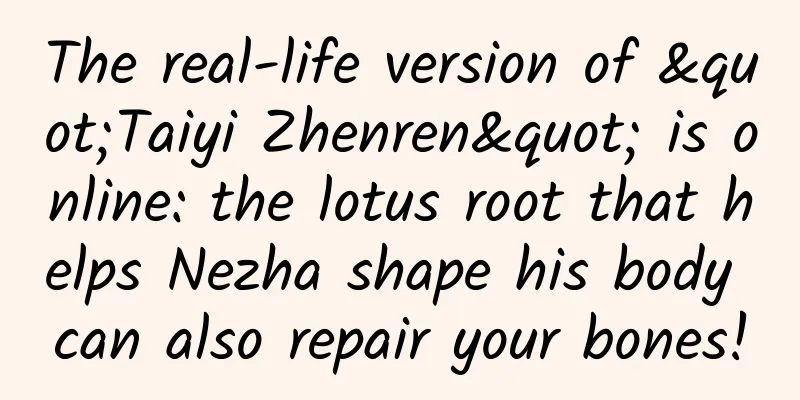The real-life version of "Taiyi Zhenren" is online: the lotus root that helps Nezha shape his body can also repair your bones!

|
Since its release on January 29, "Nezha 2" has remained popular. Among them, the plot in which Taiyi Zhenren uses lotus root powder to reshape the bodies of Nezha and Ao Bing can be said to be one of the key plots of the movie. Image source: Nezha: The Devil Boy Conquers the Dragon King But can you imagine that this miracle that seems to only appear in myths has already become a reality? The research team of Wuhan Polytechnic University has devoted more than ten years to the study of lotus root, and finally achieved "rebuilding the body with lotus root" - using lotus root fiber to help bone repair. Let's take a look at how this is done~ 01. The secret of lotus root fiber repairing bones: naturally degradable bionic skeleton Recently, a team from Wuhan University of Technology used lotus root fiber as raw material and, based on the patient's bone injury condition, utilized high-precision 3D printing technology to achieve specific customization of bone scaffolds. These customized bone scaffolds not only have high porosity and mechanical strength, but the pore size and density can also be adjusted according to the patient's specific conditions. After implantation into the human body, they can effectively promote bone cell proliferation and accelerate the self-repair of damaged bone tissue. Preparation process of lotus root fiber bone scaffold Image source: Changjiang Cloud News In fact, the repair mechanism of this lotus fiber bone scaffold mainly includes two core elements: structural bionics and dynamic degradation. 1. Structural bionics The porous structure of lotus root fiber is 90% compatible with the microenvironment of human bone tissue. This bionic structure not only provides a "scaffold" for bone cells to grow - bone cells will grow along the customized lotus root fiber scaffold, but the interconnected channels inside the scaffold can also promote the transportation of nutrients. In animal experiments, the healing rate of the fracture site implanted with the scaffold reached 95% in just 8 weeks , and the strength of the new bone was comparable to that of natural bone. Schematic diagram of lotus root fiber bone scaffold repairing bone damage Source: Changjiang Cloud News 2. Dynamic degradation Lotus root fiber has excellent biocompatibility and will be naturally degraded after a certain period of time in the human body. The degradation rate of lotus root fiber bone scaffold can be precisely controlled by chemical modification (6 months to 2 years), which is synchronized with the bone regeneration rate. This can avoid the problems of "premature failure" or "long-term retention" of traditional materials, and does not require secondary surgery to remove it. 02. The reason why lotus root fiber has become a "magic weapon" for bone repair Every year, more than 350 million patients worldwide receive treatment for orthopedic diseases such as fractures and bone defects. Traditional treatment methods, including metal nails and titanium alloy implants, can alleviate patients' pain to a certain extent, but they also have obvious defects. For example, metal materials may cause rejection reactions after being implanted into the human body, leading to the occurrence of chronic inflammation; these rigid implants are difficult to simulate the elasticity of bones and may restrict joint movement ; even more troublesome is that after the patient recovers, the implant needs to be removed through a second operation , which increases pain and economic burden[1]. Titanium alloy implants Image source: Reference [1] These problems have prompted scientists to look for more ideal biomaterials in nature. Among the many plants containing natural fiber, lotus root stands out, mainly due to its perfect combination of structure, composition and properties . Structural advantages : Lotus root fiber has a highly porous microstructure with appropriate pore size, which can support cell adhesion and migration during controlled degradation, while also having appropriate mechanical properties. Ingredient advantages : Lotus root fiber contains 12%-15% cellulose, which can form fiber bundles with a diameter of 30-50nm after nano-processing. The hydroxyl groups on its surface can absorb calcium ions, thereby promoting bone mineralization. Mechanical adaptation : The compressive strength of lotus root fiber (10-15 MPa) matches that of human cancellous bone (4-12 MPa), and its tensile ductility reaches 20%, which can simulate the elasticity and toughness of bones [2]. Surface morphology and cross-section of lotus root fiber Source: Reference [2] 03. Multi-dimensional application of lotus root fiber In addition to bone repair, lotus root fiber has been widely used in many fields due to its excellent properties. In the medical field, lotus root fiber can be used to treat burns and scalds . Lotus root fiber dressings with silver ion coating can shorten the healing time of burn wounds to 1/3 of that of traditional gauze. In addition, lotus root fiber can also be used for nerve repair . Fiber bundles with a diameter of 10-20 microns can guide axon regeneration, improving the motor function recovery of patients with spinal cord injuries by 2-3 levels. In addition, lotus root fiber is also a good environmentally friendly material. The biodegradable packaging material developed using agricultural waste lotus root nodes costs only 1/5 of plastic. This innovative application can not only reduce the problem of agricultural waste disposal, but also contribute to environmental protection. In the field of smart sensing, lotus root fiber has also shown great potential. Scientists have used lotus root fiber with a diameter of 5 microns to detect the pH value of gastric juice and the activity of Helicobacter pylori, with an accuracy that exceeds that of traditional sensors [3]. Schematic diagram of lotus root fiber sensing Source: Reference [3] Today, the ancient metaphor of "broken lotus roots but still connected by silk threads" has been given new life through the interpretation of modern science and technology. The lotus root fiber bone scaffold is not only a breakthrough in the fields of medicine and material science, but also reveals the deep resonance between nature and human wisdom. As the researchers said: "The future of medicine may be hidden in the imagination of our ancestors about a lotus root." References [1] Zhen Zhen, Wang Jian, Xi Tingfei, et al. Application status of 3D printed titanium orthopedic implants[J]. Chinese Journal of Biomedical Engineering, 2019, 38(02): 240-251. [2] Dai Tianjiao, Gu Haoshuai, Xu Huilan, et al. Comparison of the structure and properties of several lotus root fibers with ramie and cotton fibers [J]. Shanghai Textile Science & Technology, 2021, 49(02): 6-9. DOI: 10.16549/j.cnki.issn.1001-2044.2021.02.002. [3]Yang, Author: Liu Shixin, Master’s student, Department of Materials Science, Fudan University Planning: Rain Editor: Tinker Bell Acknowledgements: Professor Ma Ruguang from the School of Materials Science and Engineering, Suzhou University of Science and Technology; and Yu Luchao, attending physician of the Department of Orthopedics, Putuo Hospital Affiliated to Shanghai University of Traditional Chinese Medicine, provided scientific guidance for this article. Cover image: Nezha: The Devil Boy Conquers the Dragon King This project was supported by the Shanghai Science and Technology Commission's Science Popularization Project (Project No.: 24DZ2304000). |
<<: Can only male monkeys be king? She broke history and reached the pinnacle of her monkey life
Recommend
Huawei Maimang 4 review: 96% positive reviews on JD.com
Huawei has the highest market share in China, and...
Why do you look ugly in the camera of your mobile phone? 3 ways to make you look as good in the video as in real life
Exploiting a bug in the phone's camera. When ...
Tik Tok product analysis report!
Tik Tok ’s functions are becoming more and more d...
Radium toothpaste, radium chocolate, radium water... You will never imagine how crazy humans are for "tonics"
In addition to the "radiation" mentione...
"Not being able to distinguish between left and right rotations" may be fatal. The Nobel Prize in Chemistry has solved a "thorny" medical problem
In the early 1960s, a notorious drug safety incid...
How to develop a hit brand: to piggyback on traffic or to create traffic?
Introduction: Good content, when spread spontaneo...
Toyota provides Tokyo with hydrogen fuel cell buses that can be used as generators in emergencies
Foreign media reports Toyota recently said it wou...
Alibaba's 2016 foreign trade strategy in one chart
[[162446]] CEO Zhang Yong said at the Global B2B ...
As a product grows from 0 to 100, what is operations doing?
When I was in college, I started to get involved ...
Does it require any handling fees to apply for a Baidu account across regions or to promote through the Baidu framework account?
For those who do Baidu bidding, they all face a p...
How efficient is AI chemist? It can complete 6 months of work in 5 days without human intervention
In recent years, to meet the growing needs of ind...
The secret to reaching 10 million users in 289 days!
An investor in the circle of friends helped to po...
"People's hope" has not yet come true: Remdesivir still needs to be verified
The results of remdesivir in treating COVID-19 ar...
Is radiation in daily life harmful to the human body?
Radiation is always a concern. But in fact, it is...









